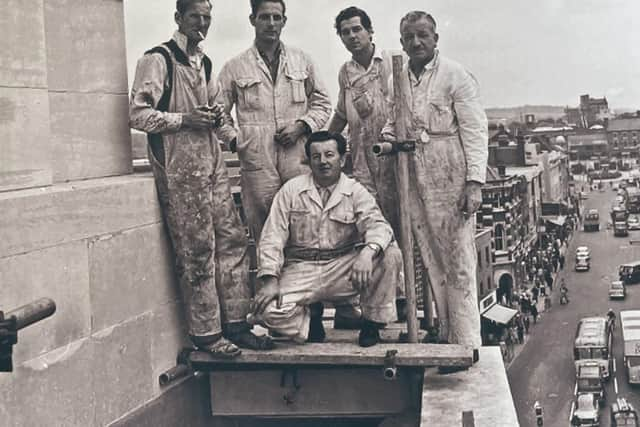Nostalgia: 86 designs entered in competition to build Luton a new town hall
and live on Freeview channel 276
A competition among architects for plans for the building was arranged by the council in 1930.
Eighty-six designs were entered, with Messrs Bradshaw, Gass and Hope winning the job. The firm designed the building, furnishing, and decorative schemes. Messrs E. D. Winn and Co. Ltd of Knightsbridge were the general contractors, whose tender of £107,640 was accepted in January 1935. Mr. W. Owen Wilkins acted as clerk of works.
Advertisement
Hide AdAdvertisement
Hide AdThis photograph, presumably taken in 1936, shows a group of workmen in overalls standing on a ledge and scaffold boards close to the bottom of the clock tower.


Despite being four floors above ground level, there is no safety equipment in sight. Below, you can see shoppers and traffic along George Street.
Built of Portland stone, with reconstructed marble in the public areas inside, it is not surprising that this town hall was designed to be fireproof, with hollow type concrete floors, brick walls, and hollow tile or brick partitions.
Following its opening, the Luton News published a six-page supplement celebrating the new building, which included detailed articles on its design, amenities, and launch event. The lead feature noted that the new town hall was, “Luton’s most impressive building. It has brought the beauty of good architecture to a town singularly in that amenity.” The Luton Section of the Master Builders Federation said it was a “beautiful building full of first-class craftsmanship”.
Advertisement
Hide AdAdvertisement
Hide AdWhile the individuals shown here were not personally recognised for their work on the project, the build included an 18-foot circular panel in the ceiling of the central committee room which showed the emblems of all the trades involved.
These included a T-square, triangle, and protractors to represent the draughtsman, a theodolite and plan for the surveyor, a paint pot and brushes for the painter, an anvil and tools for the blacksmith, flex, lamps and long-handled screwdrivers for the electrician, and a plane and chisels for the carpenter.
Today, Luton Town Hall, from the outside at least, looks very similar to the way it did when it opened almost 86 years ago.
In 2021, the building underwent a major refurbishment internally which included completely replacing the lantern roof above the Chambers and reinstating all historic fixed furniture, panelling, finishes and decorations in the room.
Do you recognise the men in the photo? Email [email protected]